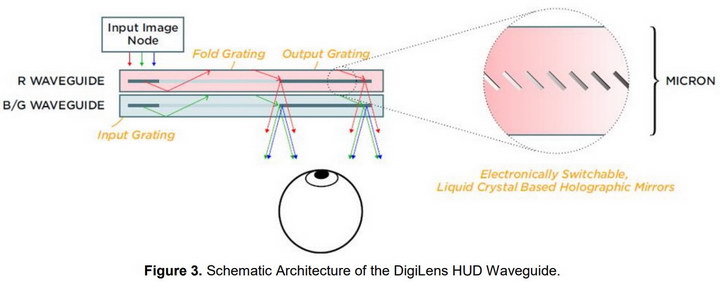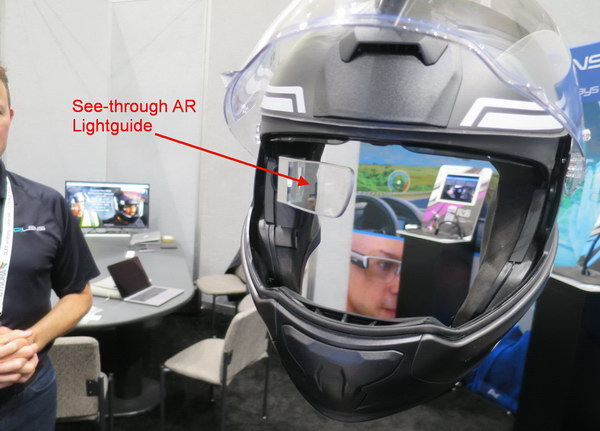At Display Week I had a chance to visit DigiLens in their meeting room on the show floor and talk to Jonathan Waldern, Founder, Chairman & CTO of DigiLens. In addition, he presented paper 17-4, “DigiLens AR HUD Waveguide Technology” in the technical symposium, in association with his two colleagues.
 (Source: SID 2018 paper 17-4)
(Source: SID 2018 paper 17-4)
The DigiLens technology is based on volume Bragg gratings that are created in a photo-sensitive polymer material using holographic techniques. These Bragg gratings can either be fixed or electrically switchable to turn them on and off. Multiple Bragg gratings can be written to the same material layer, which is the basis of the company’s latest product announcement and its paper at SID. This allows two different wavelengths to use the same waveguide. In the image above, there are two waveguides, one dedicated to red light and the other shared by blue and green light. In previous versions of the DigiLens waveguide system, there were three waveguides, one each for red, green and blue.
Sony discussed a similar two-layer waveguide design in paper 17-3. (Optics for AR and VR at Display Week – Roundup) In the Sony design, the red and blue portions of the image share one waveguide and the green uses the other. Another difference is the HOEs in the Sony design are laminated to the outside of the waveguide. In the DigiLens system, the Bragg grating HOEs are formed inside the waveguide, which is likely to protect them from damage. Sony spent much of its time in its paper discussing the aligning and laminating the HOEs to the waveguide. Neither of these processes is needed in the DigiLens production process. Dr. Waldern told me that one key process in the DigiLens system is to get a very uniform, very thin layer of the material on the substrates. He said this was done with inkjet printing rather than spin coating or other techniques which did not provide a uniform enough layer thickness.
 The DigiLens MonoHUD, which is permanently mounted on a motorcycle helmet, shown at SID. (Credit: M. Brennesholtz)
The DigiLens MonoHUD, which is permanently mounted on a motorcycle helmet, shown at SID. (Credit: M. Brennesholtz)
The DigiLens MonoHUD, a helmet mounted HUD for motorcycle or bicycle riders, was on display at SID. Previous versions of the MonoHUD design had three waveguides while the new version uses only two waveguides. The MonoHUD talks to the motorcycle rider’s smartphone via Bluetooth and can provide driving directions, text messages, play music, etc. If the motorcycle is equipped for it, the MonoHUD can also show motorcycle information such as fuel levels, chain wear, gear selected, etc.
The MonoHUD AR display is full color, has nHD image resolution and provides an unobscured user field-of-view of 105° The AR display field-of-view of 25° diagonal. It has a maximum brightness of 8,000 cd/m² and up to eight hours of battery life.
Meko’s Matt Brennesholtz tries the DigiLens EyeHUD demonstration unit. (Credit: M. Brennesholtz)
A demonstration product at the DigiLens booth was the EyeHUD. This is a monocular AR see-through system similar to the MonoHUD that is mounted on a pair of eyeglasses. Dr. Waldern told me this will launch in a couple of weeks, perhaps at AWE. The ArHUD is similar to the EyeHUD except it will be binocular. The EyeHUD will be targeted at enterprise applications while the ArHUD will be targeted at AR gaming.
Dr. Waldern told me Rockwell Collins builds the AeroHUD based on DigiLens see-through display technology. He said this unit has been certified by the FAA for use in small aircraft such as business jets.
The DigiLens business model is to develop the technology related to its volume Bragg grating technology. This includes not only the photo-sensitive materials needed and the holographic technology to create the Bragg gratings, but samples of finished components and products as well. The company does not, however, manufacture products based on its technology in volume. Instead DigiLens licenses the technology to manufacturers, helps them set up the production process and sells them the specialized photopolymers, liquid crystals and other materials needed to manufacture the end-user optical components.
Dr. Waldern told me Young Optics, the Taiwanese manufacturer of optical components and DLP projection systems, has become the latest licensee of DigiLens. While there are currently no AR or VR HMDs or automotive HUDs or components for these systems in the Young Optics product line, we can probably expect them in the near future. Young Optics has specifically licensed the MonoHUD and DigiLens says they will soon be supplying it at high volume. Sena, an industry leader in Bluetooth communications for motorcycle and action sports, is working with Young Optics to integrate the DigiLens display and its communication system into helmets to allow riders to view their phone and dash information through the display.
Young Optics joins existing DigiLens licensees which include Panasonic, Sony, Continental, Rockwell Collins and Foxconn.
Other recent news from DigiLens is they closed a $25 million Series C fundraising round a week before SID. (Continental Takes Larger Stake in DigiLens )The investment came from Continental AG, a German technology company interested in automotive applications of the company’s see-through display technology. Including its prior investment, Continental now owns 18% of DigiLens. –Matthew Brennesholtz

